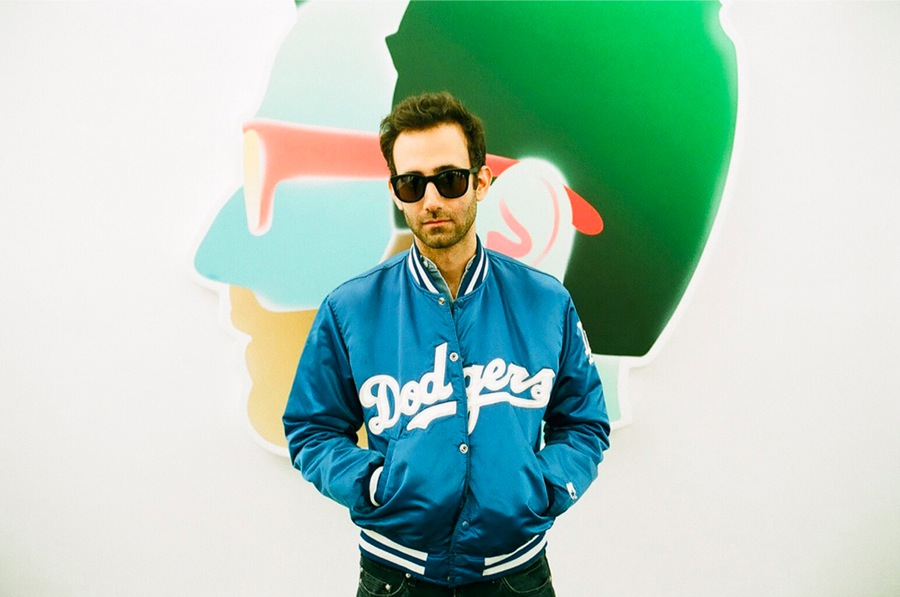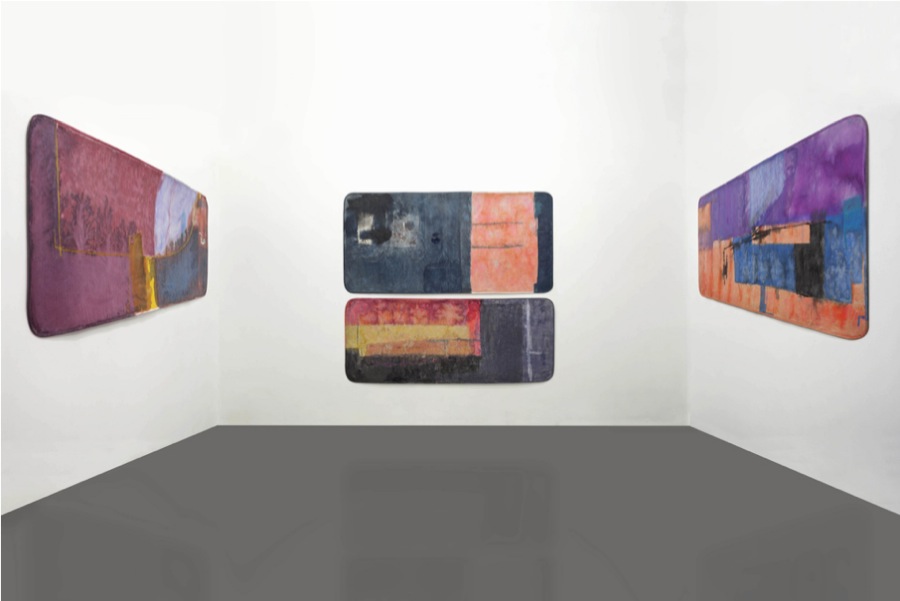- Details
- Written by Matteo Mottin
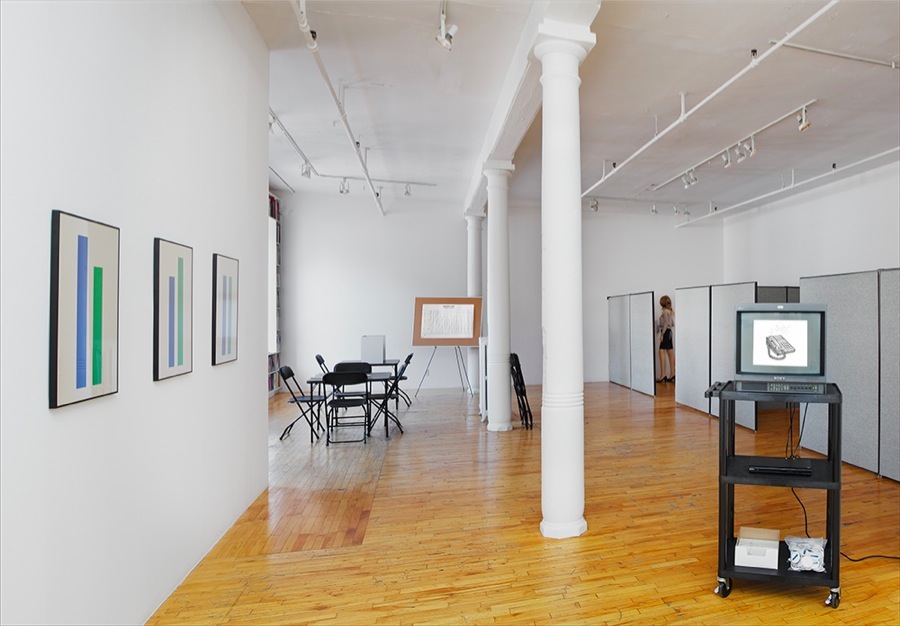
MICHAEL CLIFTON & MICHAEL BENEVENTO AND D´ETTE NOGLE PRESENT REGRESSING TO MEAN – CLIFTON BENEVENTO NEW YORK, 2014 – INSTALLATION VIEW
On April 19th inaugurates “Michael Clifton & Michael Benevento and D´Ette Nogle Present: Regressing to Mean“, the second solo exhibition by D’Ette Nogle (1974, La Mirada, CA; vive e lavora a Los Angeles) with Clifton Benevento.
Her work is often in service of the host and the particular context in which its presented. Among her works, the video “Culturally Relevant Pedagogy,” in which the artist dances with some of her students from Fairfax High School in Los Angeles, putting into practice the assumption that a teacher should learn from the culture of her students in order to develop the right educational practice; in “Reality / Relax” she pays tribute to the structure of Dan Graham’s 1969 “Lax / Relax” performance by reading at home, with her parents, some dialogue transcriptions taken from reality shows. For the 2012 edition of ”Made in LA”, the biennial organized by the Hammer Museum in Los Angeles, she played inside of the museum the bells used during meditation sessions.
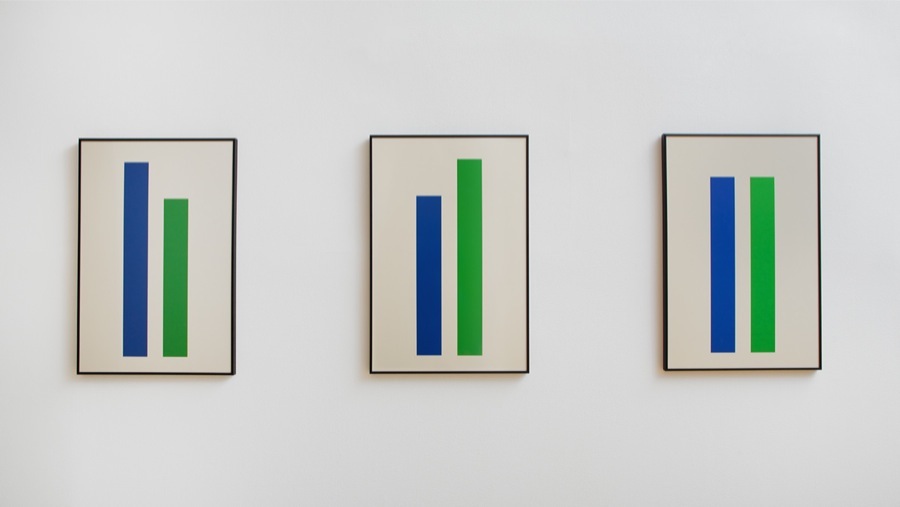
MICHAEL CLIFTON & MICHAEL BENEVENTO AND D´ETTE NOGLE PRESENT REGRESSING TO MEAN – CLIFTON BENEVENTO NEW YORK, 2014 – INSTALLATION VIEW
Matteo Mottin asked some questions to the artist.
Matteo Mottin: Could you tell me about “Michael Clifton & Michael Benevento and D´Ette Nogle Present: Regressing to Mean”? How is it structured?
D’Ette Nogle: The structure supports a testing exercise. Participants take two brief 10-question tests, Form A and Form B. The 10-question test presents visual information and the two answer choices are A) true or B) untrue. As soon as the participant completes Form A, their test is scored and they are informed of their results. Then they will complete Form B. Form B is scored and test-takers are able to determine the change between their results on the two forms of the test. They will know if they: advanced toward the mean, regressed toward the mean, or maintained a consistent position in relation to the mean. The gallery will be organized to support testing by providing an area where participants look at two tableaux that serve as prompts for the first two questions of the test and an area with a table where test-takers may sit and complete the remainder of the test questions. While test-takers wait for their results, they can also make use of a reading table where they may read material from Clifton Benevento’s extensive art library.
MM: “Regressing to Mean” reminds me about my Statistics exams… Why did you choose this title?
DN: First, there is the direct connection to the language of statistics, as you mention, and the idea that when a result is extreme in its first measurement, the second result will be closer to the average. Conversely, if the result is extreme in its second measurement, it will tend to be closer to the average on the first measurement. Also, there is a connection to the other content of the exhibition, the theme of schadenfreude and the potential connection between “meanness” and low self-image on the part of the person feeling schadenfreude. Finally, using elements from my previous show at Clifton Benevento (the office partitions), there is an intentional regression to mean or to communicate a link to my first show at the gallery which is then intended to convey a comparison between the two shows and highlight the vulnerability of the art practice to evaluation or assessment–which is often self-imposed (e.g., “Has she improved or regressed?” or “Have I regressed or is this an improvement?”)
MM: In this exhibition you overturn the common relationship artist-viewer within the exhibition circumstance: here you use a test to give marks to the visitors, and these marks are based on the answers given by a gallery representative. Could you tell me about the reasons behind that?
DN: I see it as an opportunity to consider the typical circumstances that determine how art is viewed and evaluated. In the testing exercise, one person’s subjective answers are compared to another’s, that of Silke Lindner, an employee of the gallery. People working at galleries are often called upon to provide answers to questions about the artist and the art on view. In this case, you have the opportunity to see how your interpretations of the work compare to hers.
MM: You’re using the same grey office partitions you used in your first solo exhibition with the gallery, “Michael Clifton & Michael Benevento and D’Ette Nogle Present: Information from Two Sources” (2012). Besides that, is there any other connection between these two exhibitions?
DN: Each of the two tableaux residing within the office partitions present a scenario, one involving a blonde female and one involving a male. In Information from Two Sources, there was a video within each partitioned space, one presenting the text from an Elle magazine article about the lifestyle of the actress Blake Lively whose role on the series Gossip Girl is characterized in the article as “the perfect escapist heroine for our recession-era daydreams,” and one presenting the narration of a viral video made by an investment publisher named Porter Stanberry called “End of America.” In the video, Stansberry employs fear-mongering and advises potential investors to invest in as much gold and silver as they can afford. Another link to the first exhibition will be a series of three Thematic Posters for Exhibition (Improving, Regressing, Norming). Each of the three will graphically represent improvement, regression, and a consistent relationship to the mean. In the first show, there was an “Investment Opportunity” which presented a portfolio of prints based on scans of my hair, one gold portfolio containing color prints of my blonde hair and one silver portfolio containing black and white prints. I see the “Investment Opportunity” and the Thematic Posters, in their representation of value variations, as an opportunity to consider how art and artists are collected and valued.
MM: This exhibition builds around the notion of schadenfreude, i.e. the joy derived from the misfortunes of others. Why did you decide to deal with this topic?
DN: As a statistical phenomenon, regression toward the mean is also associated with “second-year syndrome” and “the sophomore slump”. I’ve been considering the “sophomore album” and the projections we might be placing on performers or other producers. When we perceive someone’s diminishing success, we may actually be seeking the experience of schadenfreude. When the value judgment is placed on the production of art or some other form of cultural expression, it is difficult to attribute it to the statistical phenomenon or a desire within ourselves. The investment of art largely operates within set conditions that determine value and affect what, by extension, will be valued by others. Within these conditions, it’s difficult to determine what is “true” and what is “untrue.”
Until May 24. The gallery is located at 515 Broadway between Broome and Spring streets, New York. Opening hours are 11am-6pm Tuesday though Saturday.
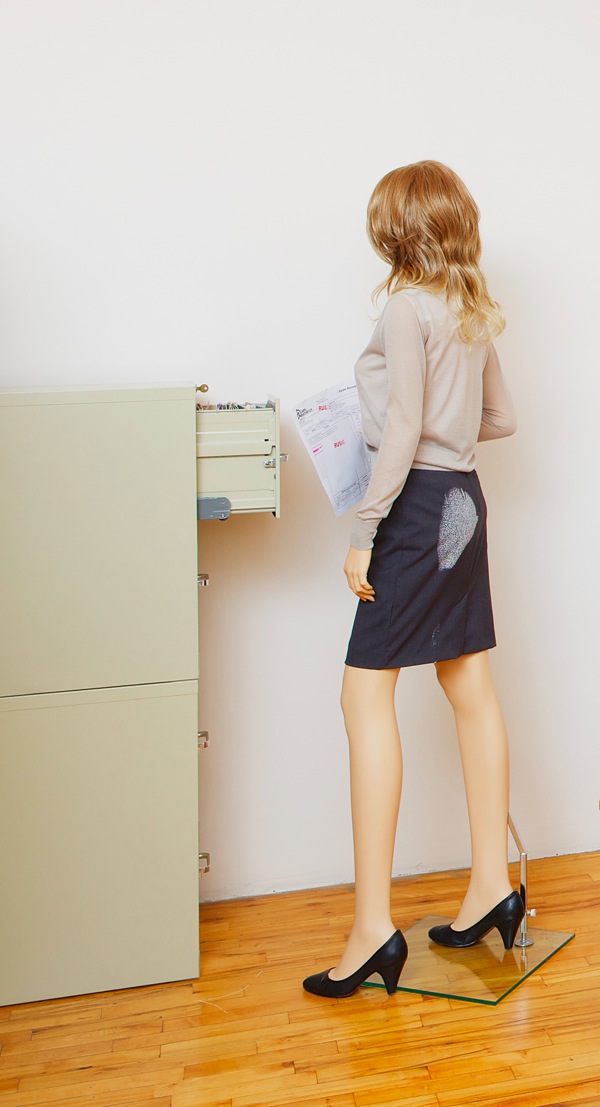
MICHAEL CLIFTON & MICHAEL BENEVENTO AND D´ETTE NOGLE PRESENT REGRESSING TO MEAN – CLIFTON BENEVENTO NEW YORK, 2014 – INSTALLATION VIEW
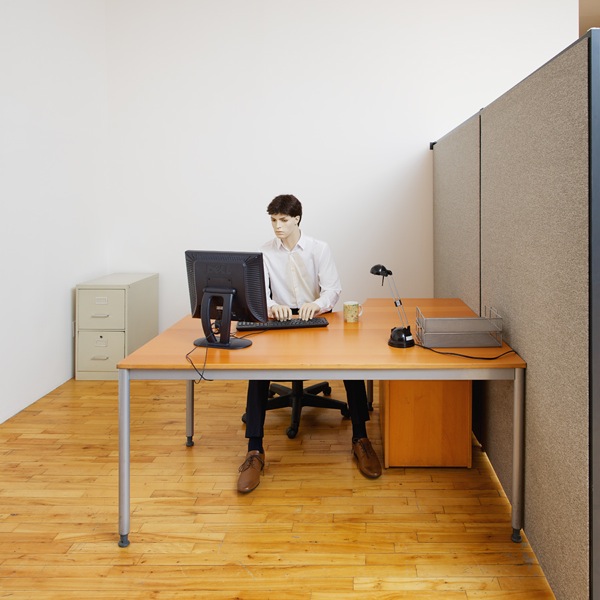
MICHAEL CLIFTON & MICHAEL BENEVENTO AND D´ETTE NOGLE PRESENT REGRESSING TO MEAN – CLIFTON BENEVENTO NEW YORK, 2014 – INSTALLATION VIEW
 |
Written by our friends at ATPdiary.com in colaboration with Matteo Mottin |
- Details
- Written by Calíope Garmendia
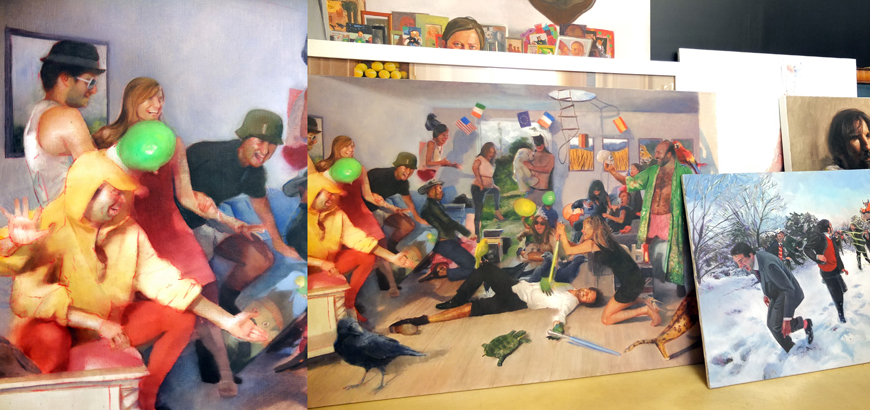
You don’t make a such a discovery every day. Not long ago I picked up a random stranger, unknown to most, with a growing influence on national art circles. My encounter with him happened out of pure chance, but that’s a whole other story. His name is Íñigo Navarro.
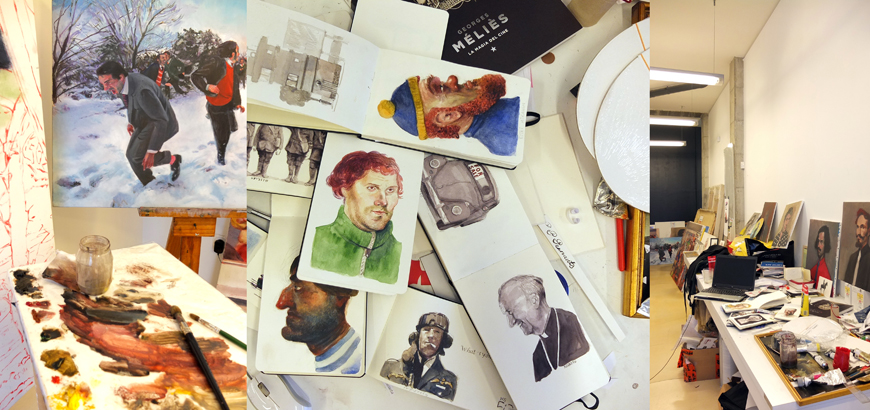
Here’s the conversation we had in full: it’s certainly worth a read.
“May I come in?”, I said timidly from the corner of the studio.
“Just a moment, I’m getting dressed!”
“Oh goodness me, ‘getting dressed’?”. Navarro appeared a couple of minutes later wearing a leopard-skin dressing gown and a dazzled expression.
“Holy Mary, you’re beautiful! Are you a goddess?” Before answering him, I grabbed the can of pepper spray that I always carry in my jacket. He looked harmless enough, but you can never be completely sure with artists.
“Well… I’m Calíope, Calíope Garmendia.”
“And what have you come here for, Calíope Garmendia?”
“I was curious, I wanted to find out more about you and your work. What were you doing there naked, anyway?”
“I was exploring my body.”
“OK, never mind…”
“Oh no, no no no, it’s not what you think… I have a friend who’s a performance artist… How can I put this? He undresses in inappropriate places, like the men’s toilet of a bar — there’s always someone who gets angry and ends up attacking him. He then goes back to his studio and takes photographs of his wounds. He puts the photographs together in series of five and sends them off to his gallery in Cologne, who pay him handsomely for them. He believes that an artist simply resides in a body, and that knowledge of one’s own body is absolutely essential. I personally am very interested in the conceptual relevance of my work, which is why I spend a lot of time carefully studying each single element of them.”
“This friend of yours seems interesting, perhaps I could interview him too.”
“Of course — I’ll put you two in touch as soon as he’s out of the hospital.”
“What? On second thought, forget it, let’s get down to business. I want to talk about you. I can see that your studio is full of your work, and some pieces are very large. For example, how big is this one over here?”
“Three metres tall. Actually, I think it’s too small. I’m preparing a large event in Ávlia, with more than a hundred models, and I want to have the models in the foreground look like they’re life-size. This means that my next painting will need to measure four metres by eight.”
“The models will be in fancy dress, right?”
“It’s a ceremony, an interpretation of the exotic cruelty that’s all around us. Would you like to take part?”
“Not for now, thanks. Could you tell me more about these anthropological digressions you just mentioned?”
“Of course. What I meant was that we still celebrate the bloody bull runs of Pamplona, we send enxanetas to the top of the Castells (human towers) without fear of their death, atheists shed tears accompanying the Macarena, we walk bare-foot over burning coals, parents happily buy their children fireworks to celebrate the mascletades, among many other peculiarities.”
“Spain has changed a great deal.”
“It’s certainly true that we have changed, and we’re many other things now, but these other things, which can in fact be found everywhere else in the world, don’t interest me as much. Nor do I think they are particularly interesting from an artistic point of view. This is exactly what globalization in art is about, a conceptual homogeneity that is terribly harmful to creativity.”
“Is this why you paint?”
“Actually, yes. Spanish painting education is world-renowned. If we can learn something from the relentless tautology that is contemporary art discourse, it is that there is no technique that is superior to others. By choosing painting over newer artistic media, I do away with all the showy, technological factors that new media bring with them, and in so doing I can get straight to the core idea that I want to express. And paradoxically, I also distance myself from institutional tendencies, from contemporary academicism.”
“What is that idea?”
“Fatality. Whatever we may do in life, we end up dead. I’m interested in everything we do to fill our days until our time comes to die. Deciding to occupy one’s time with such an old activity as painting can be considered a joke or something extremely important — it’s ambiguous. I personally don’t fear death.”
“Really?”
“Of course not; I’m convinced that death is not final. In fact, I can prove it to you mathematically. Would you like me to show you?”
“No, thank-you! By saying that “death is not final”, are you not contradicting your beliefs in fatality?”
“Well… no. I’m generalizing. Here in the West, we are living in the best time that we’ve ever seen, yet I think we can see symptoms of decadence. Materialism is the new God, and this brings its own dangers. People’s greatest fear is death. This has never happened before in the history of humanity, and its consequences on our daily lives — let alone on art — are far more serious than we think.”
“Are you saying, then, that belief in God is a prerequisite for creating great art?”
“No, certainly not, but it does help. You can’t just make something exceptional by sitting around. You need to invest many hours of hard work without the certainty that you will be rewarded with a great piece of work. Some kind of faith — any kind, it doesn’t really matter which — is required in order to overcome this phase without falling into materialist temptations. Would you like a coffee?”
“No, thanks.”
“I’ll put one on for myself, if you don’t mind.”
“Many artists find it difficult to talk about their work, but you don’t seem to have any trouble doing so.”
“On the contrary, I love talking about the work I do. I spend hours on the phone talking to my colleagues about art, like an excited teenager. Perhaps something I don’t do is explain my work in detail. The only way I can explain my work is by exhibiting it. I create my work for it to be shown — that is how it reaches its expressive peak. At one of my exhibitions, Scope London, a gentleman from Bristol got so emotional at the sight of one of my photos that he couldn’t help but relax his sphincter muscles.”
“Oh my goodness.”
“He farted so loudly that he ended up buying two photographs”.
“Disgusting!”
“Poor man. I have never felt so honoured by a visitor’s reaction to my work as I was then.”
“Who are your references?”
“In terms of writers, Conrad, Kennedy Toole, Sharpe, Amélie Nothom. In terms of artists, I’d single out two, among the many that I like: Velázquez — not only for his clear technical ability, but also for his sensitivity and worldliness — and Antonio López, for what he taught me in his workshop and for being a true artist, full of energy and love towards painting. If I had to pick a soul-mate in the art world, I’d choose Berlanga, the late film director, God bless him.”
“A film director!”
“Berlanga was a genius story-teller, without ever taking away the mystery that is always present in a work of art. That’s my leitmotiv: to express myself, and to be understood, without losing the magic.”
“What are you working on now? What will you do with all this work in the studio?”
“What you see here are four years of research. In these four years I have tried to understand what it is that I do best, and how to express it. It’s a complex and ambitious project, and I aspire to immortality.”
“You’re certainly not modest, are you?!”
“Quite!”
“It’s been a pleasure.”
“The pleasure is all mine. It’s rare to be visited by one of the nine muses from the distant city of Argos.”
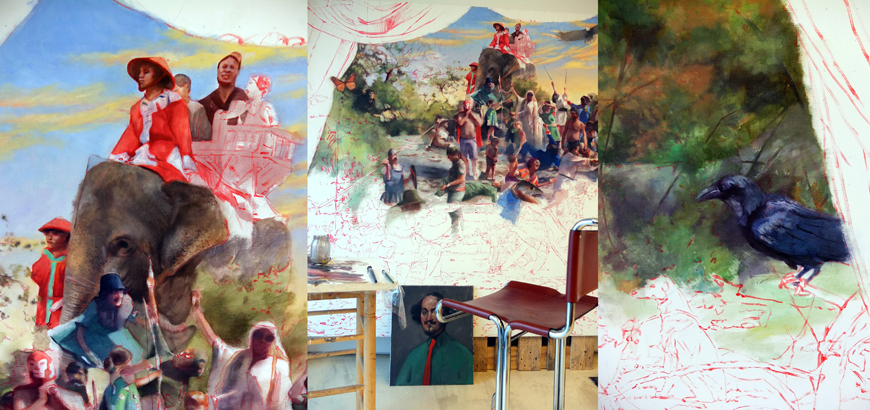
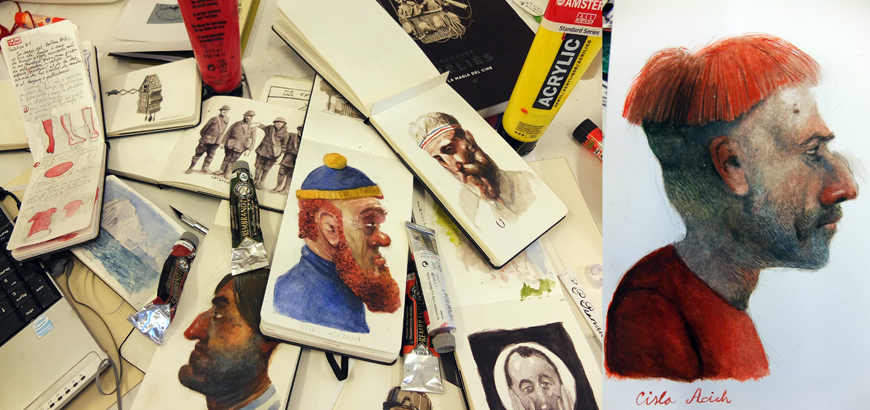
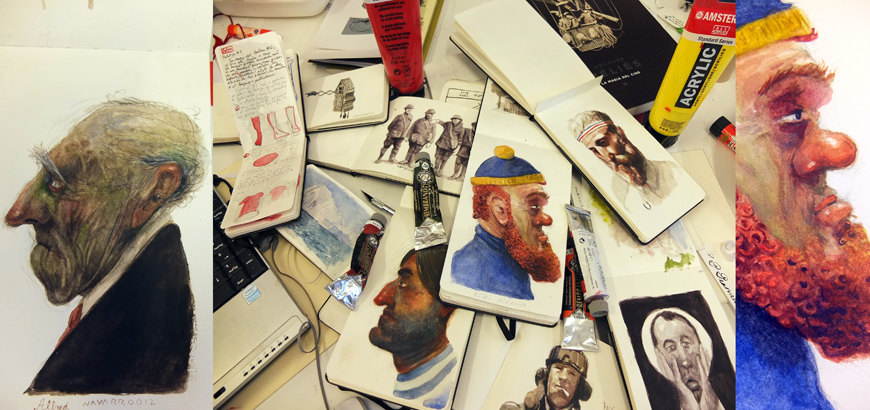
To learn more about this fascinating artist, visit www.inigonavarro.es.
- Details
- Written by Matteo Mottin
|
Autor colaborador: Matteo Mottin |
 |
From January 16th Gagosian Gallery Rome hosts a two-person exhibition by Kathryn Andrews (Mobile, Alabama, 1972) and Alex Israel (Los Angeles, 1982). Both artists share a peculiar characteristic: they use temporality and contingency as new parameters for readymades, as a sort of renewal of Duchamp’s undermining of the status of authorship. Furthermore, they’re both based in Los Angeles and they’re interested in the culture of the local film and media industries. The multifaceted nature of Andrews’ work reflects her sensitivity to the decentralized urban sprawl of Los Angeles. Often she combines a meticulously fabricated “framing” element with a second notable object, the juxtaposition of which invites a multitude of implied narrative projections, while simultaneously de-stabilizing traditional assumptions about the formal hierarchies of sculptural pedestal, armature, and object.
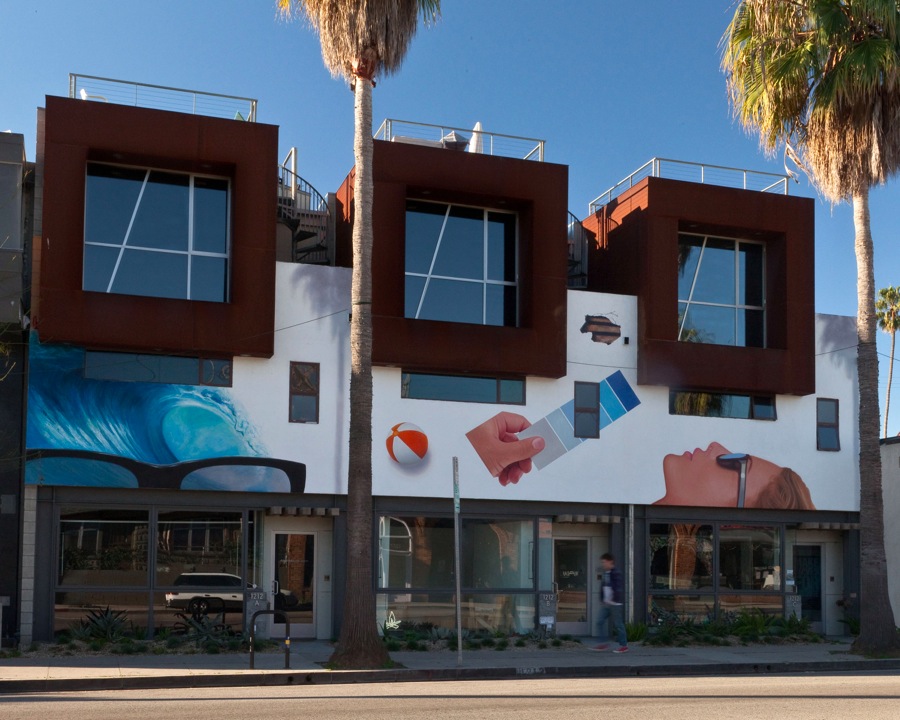 |
| Alex Israel, “Abbot Kinney Mural”. Foto: Michael Underwood |
 |
| Alex Israel, Museo Civico Diocesano di Santa Maria dei Servi, Città della Pieve. Foto: Ornella Tiberi |
Los Angeles is also a strong presence in Alex Israel’s work: from the set of vertical backdrop panels shaped like the windows and the doorways of the Spanish Revival homes of Hollywood’s Golden Age, painted with a thousand of overtones recalling the colors of LA Valley sunsets, “natural” environment for the rented movie props he exhibits as readymade sculptures, to “As it Lays”, his cult series of video-portraits of such notable locals as Rick Rubin, Marilyn Mason and Christina Ricci, just to name a few, to which he ask such harmless questions as “if you were to create the perfect salad, what would be the key ingredients?”.
The city is also an implicit presence in the name of his sunglasses’ brand, “Freeway Eyewear”.
Matteo Mottin in conversation with Alex Israel.
ATP: I know you’ve been to Cinecittà recently.
Alex Israel: I first went to Cinecittà last year in preparation for my first exhibition in Italy, which was in Umbria, in Città della Pieve, in a beautiful deconsecrated church with a Perugino Fresco, that is now a museum: Santa Maria dei Servi. I went to Cinecittà looking for props to rent, to use as sculptures for the exhibition as part of my ongoing sculptural project: Property. Employing cinema props as readymade sculptures is something that I’ve done in Los Angeles, New York, Berlin and Paris. When I returned to Cinecittà earlier this month, in anticipation of this exhibition at Gagosian Gallery in Rome, it felt like I was coming back to visit some old friends, the incredible props in the “Plastica” department at the studio. My selection process, choosing which props to use, is a lot like casting actors for a film. I walk the aisles at the prop houses, auditioning the objects for the role that they would have to perform in a show: the role of readymade sculpture. I look at the objects and I consider which ones have the most star quality. It’s really hard to explain what exactly I’m looking for–it’s an unmeasurable and ineffable quality–it’s something that you just feel. I spend a lot of time looking at things, taking pictures of the things that resonate for me, and then I begin making a selection. At this point it sort of becomes a “call back” situation, before the final selection is determined. Part of what inspires the selection is how the different objects relate to each other, and how I think they would work as a group or as an ensemble cast, working together in an exhibition. Because this is a two person show, of my own work and Kathryn Andrews’ work, there was definitely a consideration of how any objects that I might choose would relate to her works as well.
I believe that cinema props accrue a kind of magical property, or stardust, over time, through their experiences in film or on television. I feel this quality emanating very strongly from the objects that I’ve discovered here in Italy.
ATP: I read in an article about you that the subject of your research is the vacuity of celebrity culture, so I wanted to ask you…
A.I.: Sorry, that’s not correct. Not at all. I’ve never said that and I think it’s important to point that out here and now. I’m not interested in vacuity or emptiness. I think that celebrity culture is our culture, and I’m really interested in it and inspired by it. Some of my work engages celebrities. A lot of the celebrities I’m interested in are people that have made groundbreaking decisions that have paved the way for other people to follow in their footsteps. This is the fabric of our culture, and it’s neither empty nor vacuous.
A.I.: You invented a new way of intending readymades, giving new meaning to what they can be. How did you come to this? How did it start?
I was in art school and I was having an existential moment, not knowing what to make, or how to produce artwork. At the time I was genuinely convinced that I did not want to make art objects that could exist permanently as artworks and circulate in the art market system. On the other hand, I wanted to create art experiences that could be sculptural or physical for the viewer, much like the experiences of art objects I’ve had in the past–experiences that I’ve truly loved. I came to the conclusion that the best way for me to deal with this paradoxical interest, and to address the entertainment culture that is so interesting to me, and so much a part of life in Los Angeles, was to start thinking about renting cinema props. I started going to prop-houses. In LA we have so many of them and together, spread out across the landscape, the prop houses constitute a kind of library of objects. I just started going to them, taking pictures while learning, from experience, how certain things I’d come across might speak to me. At the same time, I was making sunglasses, and I was making videos for the internet. I insisted that my sunglasses were not precious, they were just a product that could exist in the world, and I knew that my video were also not precious, because they existed online and anyone could download them. I also knew that I didn’t want to alienate the possibility of participating in a dialogue that exists around the art gallery context. The idea of renting props, each able to perform the role of sculpture in a gallery, satisfied everything that I was looking to engage in my work at that time. Everytime I make new works in this way, I reconfirm my belief in the power, magnetism and magic of these inanimate cinematic objects.
ATP: So it kinda rises from an inner necessity.
A.I.: For as long as I can remember I’ve been making art. I studied art in college, and after college I worked in the art world. I experienced the art world from many different points of view: from working with artists, to working at art museums, to working with an auction house and two galleries. I saw the art market balloon into this incredibly powerful force, at times overpowering art itself. When I started graduate school in the fall of 2008, the subprime market crashed, and the art market changed along with it. I had collected a lot of experiences, and a lot of information during that time between college and graduate school, but I was still processing all of it. I didn’t know what to make of it and I guess that’s where the existential mindset came into play.
ATP: Sunglasses always remind me of “La Dolce Vita” and “8 1/2″. The way the characters wear sunglasses in Fellini movies is particular, almost ambiguous, as if they were children pretending to be grown ups, using them to shield their immaturity.
A.I.: Sunglasses are really interesting to me when I stop and think about them. I like how sometimes people wear them to hide, while other times people wear them to be noticed. They have this special quality that changes people: when people put them on, they instantly feel cooler. They’re kind of like a healthy version of smoking a cigarette. For those of us who live in Los Angeles, they are very simply a part of our everyday lives–you put on your underwear and you put on your sunglasses. So on the one hand they’re glamorous, and on the other hand they’re completely banal. I love these dualities, but I also Iove that at the root of it all, sunglasses frame and filter what we see, and they do it so effortlessly.
ATP: A last question: if you were to create the perfect salad, what would be the key ingredients?
A.I.: That’s a good question. Romaine, rucola, spinach, tomatoes, parmigiano cheese, chicken, green beans, corn, pecans, pomegranate seeds and light balsamic vinegar dressing. And avocado.
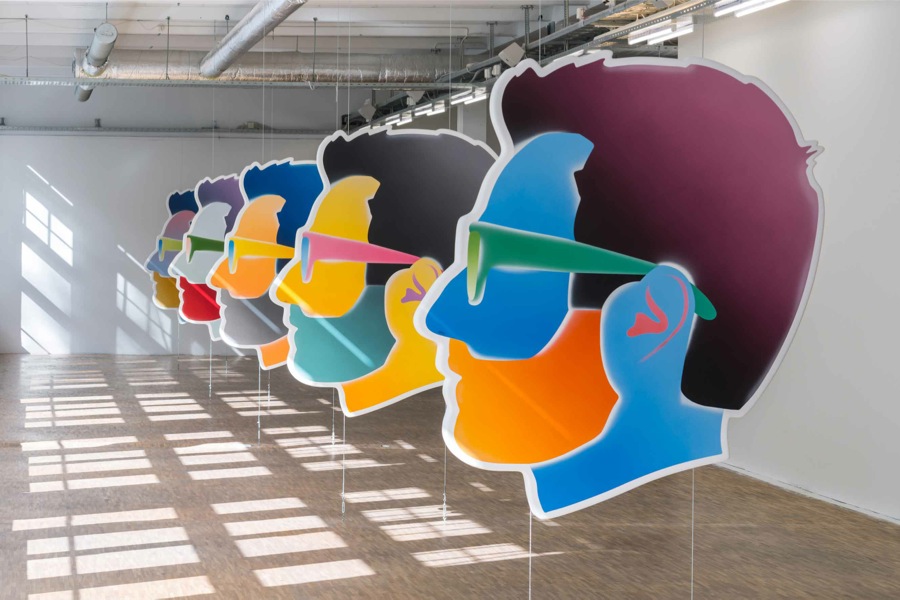 |
Alex Israel Veduta dell’installazione di autoritratti del 2013 ad Isbrytaren, prodotta a Stoccolma da Carl Kostyal. Foto: Jean-Baptiste Beranger |
 |
| Alex Israel, “As It LAys” dalla mostra personale del 2013 presso Le Consortium a Digione. Foto: Zarko Vijatovic |
 |
Written by our friends at ATPdiary.com in colaboration with Matteo Mottin |
- Details
- Written by Matteo Mottin
|
Autor colaborador: Matteo Mottin |

|
Interview with Henrik Olai Kaarstein in occasion of his exhibition ‘Mothers’ at T293 Gallery (Naples)
|
|
|
HENRIK OLAI KAARSTEIN, ‘MOTHERS’, INSTALLATION AT T293 NAPLES,COURTESY T293, ROME-NAPLES FOTO: MAURIZIO ESPOSITO |
ATP: In “Turning and Returning”, your previous exhibition with T293, you were showing “material collages” made with sheets and towels “found” in hotel rooms and saunas and assembled so as to fill the typical aseptic and empty void of those places. Is there a connection between these works and the ones you show in “Mothers”?
Henrik Olai Kaarstein: I’m drawn to the intimate, private and sexual connotations to these materials. They are heavy with information, insinuation and emotion even before I manipulate them. Making a fabric ”dirty” with paint and colours. Putting my hand on them so they never can be clean or fresh again. I guess in ”Turning and Returning” the idea of collecting and gathering materials was more present than in my newer works. As I never really was that concerned with the personal narrative of these objects, or the gesture of putting these everyday objects into a gallery space, I moved away from it. It’s always been more about the physical qualities of the fabrics that I didn’t have control over and had to work with and work around.

HENRIK OLAI KAARSTEIN, ‘MOTHERS’, INSTALLATION AT T293 NAPLES, COURTESY T293, ROME-NAPLES FOTO: MAURIZIO ESPOSITO
ATP: There’s been a clear evolution in your works, from the ones presented in “Projectile Weapons”, through “Idea is the object” at D’Amelio Gallery, to “Mothers”. Can you tell us something about this path?
H.O.K.: The word path is a bit farfetched. Of course there’s been progression and development. It’s getting more important for me to look back at earlier works as a way of evolving, retrospective investigation. It’s nothing complacent with a bit of self-referentiality. It’s almost like admitting defeat and accepting that there are still issues that need to be examined.
ATP: ”Mothers” is a title that evokes feelings at the same time personal and impersonal. Can you explain us the reason behind this choice?
H.O.K.: I like writing words down as a method of working and framing my work. It’s part of a notebook for sketching and ideas. Most of my ”ideas” are not visual illustrations, but come more in the form of sentences, quick assembling of words etc. I like cementing ambiguities on paper. Looking at the title “Mothers” standing alone on a piece of paper was odd. It has a great duality to it like you mentioned. It is a warm word, but also feels like a cold title. It’s harmful and dangerous somehow. Like a pack of angry lionesses. In the specific situation of the exhibition, the intimacy of the materials it turns perverse and incestuous. The plural form of the word swiftly disarms all of these connotations with impersonality, like it implodes into nothing and is suddenly pointing everywhere. Mothers represents acceptance and embracement and therefore also functions as a wink to what I describe as ”aggressive femininity” in the exhibited works and ”sisterhood” of the seriality. It is a crowded, yet democratic installation. No individual work is allowed to be more important than its siblings.
ATP: The works in the exhibition are characterized by simple basic materials such as towels and mattress covers. On these everyday objects you paint enigmatic and ambiguous landscapes. Can you tell us about the link between these two parts, the base and the paintings?
H.O.K.: I’m not sure if there’s much to tell. The surfaces lie on my dirty floor so I can circle around it, occasionally diving in after a decision is made. I just add with what makes sense, puzzling together a solution and struggle to make all aspects connect. A lot of water is mixed with the paint. It’s a long process of water damage and drying, hiding mistakes and sometimes seeing mistakes as success. Repeat, add and rework as many times as I feel necessary. There are a lot of limitations when you work on something mass-produced. I need limitations to focus and control the visual delegation. Continuously adding liquids to objects made to repel and suck up moisture that never will be clean and pure again was the starting idea. Performing as aesthetical objects instead of functioning. It’s a great combination of sad and sexy.
ATP: From the text that goes with the exhibition: “powerful resources and will are used to lay bare and point out the existence of repressed information”. What kind of repressed information do your works hide?
H.O.K.: “Prejudiced longings”, are the two last words of that press text. I just want to point out where. I’ve never been a who-what-why-man.
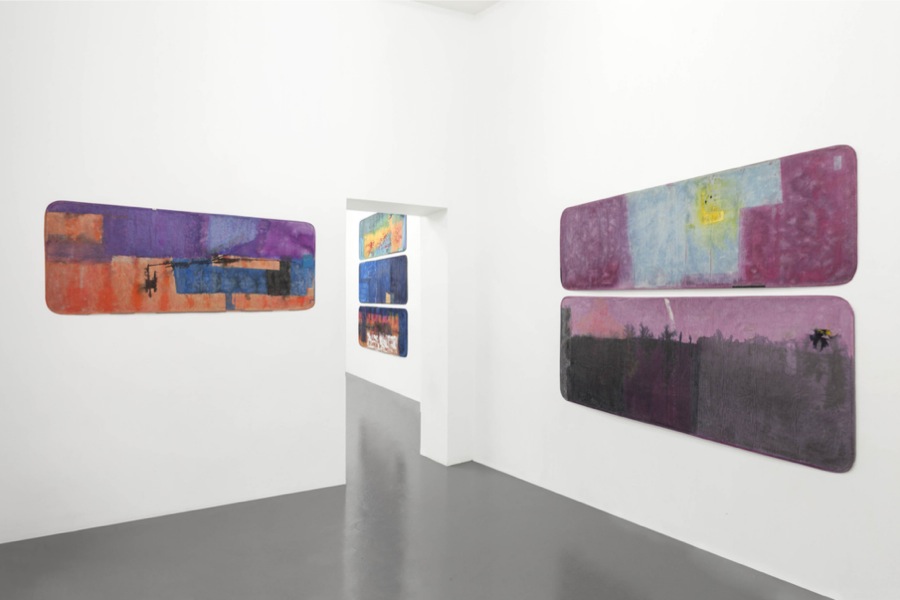
HENRIK OLAI KAARSTEIN, ‘MOTHERS’, INSTALLATION AT T293 NAPLES, COURTESY T293, ROME-NAPLES FOTO: MAURIZIO ESPOSITO
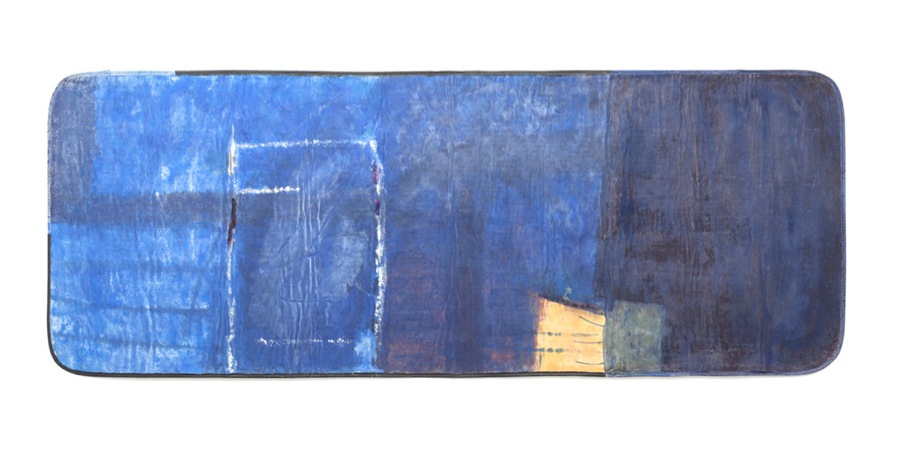
HENRIK OLAI KAARSTEIN, AND YOU DESERVE ALL 5, 2013, ACRYLIC PAINT, IRIDESCENT MEDIUM, ACRYLIC GLUE AND SILICONE ON MATTRESS PAD : PITTURA ACRILICA, MATERIALE IRIDESCENTE, COLLA ACRILICA E SILICONE SU COPRIMATERASSO, 75 X 200 CM, COURTESY T293, ROME-NAPLES FOTO: MAURIZIO ESPOSITO
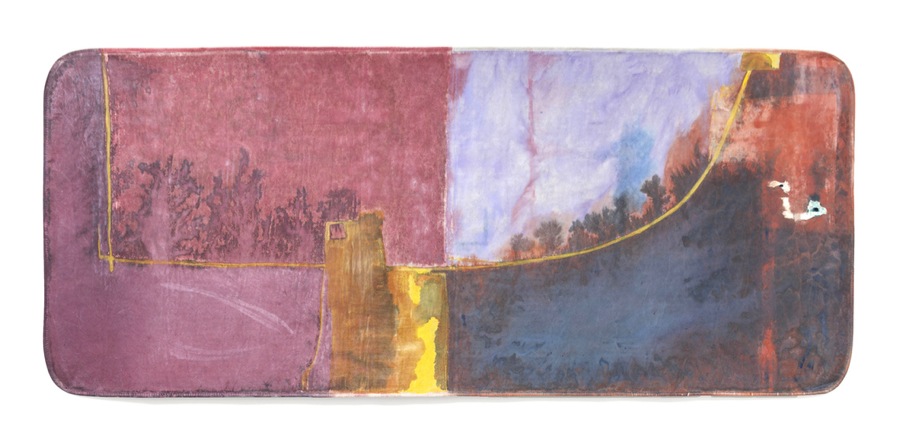
HENRIK OLAI KAARSTEIN, AND YOU OWN ALL 4, 2013, ACRYLIC PAINT, VINYL PAINT, ACRYLIC GLUE, IRIDESCENT MEDIUM ON MATTRESS PAD : PITTURA ACRILICA, PITTURA VINILICA, COLLA ACRILICA, MATERIALE IRIDESCENTE SU COPRIMATERASSO, 85 X 200 CM, COURTESY T293, ROME-NAPLES


